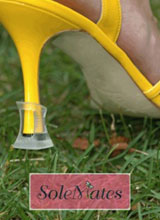While posing for photographs before her high school prom, Becca Brown’s high heels sank into the grass. She found herself stumbling around at a time when she most wanted to appear mature and sophisticated. The experience inspired SoleMates, the business Brown launched on the Internet in 2008 with former Goldman Sachs colleague Monica Murphy. The pair designed a plastic cap with a wide bottom that can attach to high heels to provide a more stable base while walking on uncertain terrain, such as grass or cobblestone streets.
Although getting stuck was the problem that led to the founding of SoleMates, Brown hasn’t allowed inflexibility toward change to trap her business in a web of inertia. As part of a panel discussion at the recent Wharton Women Business Conference, she and three other female entrepreneurs showed how the ability to compromise is key to long-term, positive growth.
In addition to Brown, the other speakers at the panel, titled “Women Pursuing Innovative Ideas: Ventures that Create Buzz,” included Stacey Bendet, founder and CEO of New York clothing company alice + olivia; Jennifer Hyman, co-founder of dress rental company Rent the Runway, and Susan Smith Ellis, CEO of (RED), which raises money for AIDS research and treatment.
Brown and Murphy originally envisioned selling SoleMates in stores that ran the gamut from Walmart to specialty boutiques. After reaching out to mass merchandisers and department stores, however, the pair decided that starting small offered more advantages. “We realized the better way to build the brand was to grow more organically, to go into boutiques or to wedding planners where there would be a more memorable experience than going to Target or Walmart, where we would be in a sea of products,” Brown noted.
She believes that concentrating marketing and sales on boutiques and wedding planners will build a following for Connecticut-based SoleMates and convince customers to pay more for the original if and when lower price knock-offs begin to appear. Brown and her partner are currently the company’s only employees.
“Has it been difficult to launch a consumer product in this economy? Yes,” stated Brown, who quit her job to launch the company in 2008, just as the global economy began to crumble. But she and Murphy are pitching SoleMates as a necessity. “It’s an insurance product against losing a heel and preserving the assets we already have by extending the life of our shoes,” she said.
If It’s Broke, Fix It
Initially, the signature look of alice + olivia was fanciful pants that Bendet made out of rich, but stiff and unforgiving, fabrics. Her company designs and manufactures clothes that are sold in more than 800 outlets and five-company owned shops in high-end areas.
Bendet’s business model changed once she took on a new partner, long-time garment industry executive Andrew Rosen. He pointed out that the pants sold well in sizes 0 and 2, but the company was lacking in sales volume across all sizes. “Andrew said: ‘Your pants need stretch. Change the fabrics,'” Bendet noted. She went along with the idea, and pants of all sizes began to move rapidly out of the stores. “Even if you don’t want to change, you’ve got to try it,” Bendet suggested. “You can change again if it doesn’t work.”
Rosen also helped alice + olivia develop new manufacturing networks in Asia that allowed the company to offer better designs at more affordable and competitive prices. The company will continue to evolve: Plans are in the works to launch more retail stores and to rely less on the wholesale model in order to grow “without being a prisoner to department stores and others,” Bendet said.
Former Omnicom Group marketing executive Susan Smith Ellis was challenged by U2 frontman Bono to turn (RED) into an ongoing, sustainable private-sector approach to supporting the fight against the AIDS pandemic in Africa. The idea was inspired by the successful fundraising efforts of one-time emergency appeals, such as the Live Aid concerts. “It was a daunting task, although it is less daunting now,” Ellis stated.
She started out with a model that included partnering with corporations such as Starbucks, Nike and Gap. Each time consumers bought specially designated (RED) products, the companies donated a percentage of the sale to help eliminate AIDS in Africa. The partnerships also created visibility that drew consumer interest and helped Ellis recruit additional partners. “I knew from my years in marketing and branding that consumers want companies to do more than just make a profit,” Ellis said. “Companies are not there to give money away; it has to be good for them, too.”
Eventually, however, (RED) had to diversify. The New York-based company, which has 30 employees and also maintains a small office in London, has branched into other initiatives including (RED) Wire, a digital music service. Ellis also helped to produce a 2008 Valentine’s Day art auction that raised $42 million for The Global Fund to Fight AIDS, Tuberculosis and Malaria. In July 2009, the group said it had raised $130 million for AIDS patients in Africa. “(RED) is the catalyst. It is the organizing principle,” Ellis noted. “You learn as you go and you have to adapt. We stayed true to the original idea, but expanded the model.”
Caviar and Tuna Fish
Jennifer Hyman’s idea to create New York-based Rent the Runway, a service that allows women to rent designer dresses at a fraction of the cost, was inspired by her sister’s efforts to satisfy caviar taste in fashion on a tuna fish budget.
But her business plan came to fruition, in part, thanks to harsh criticism she received while gathering input from leading designers and retailers. Hyman approached designer Diane von Furstenberg and Bergdorf Goodman CEO James Gold up front to curb potential industry opposition or efforts to kill her company. Rent the Runway delivers dresses by courier to subscribers who order them over the Internet, much like a Netflix movie.
Gold and von Furstenberg each told Hyman that “‘there is an idea here, but here are the problems I have with it,” she said. “Then I came up with a model to address the problems and create something that might be beneficial to the community.”
Hyman, who used to work in the hotel business, believes that renting designer dresses alleviates the cost burden on women trying to develop their own sense of style. It also would encourage customers to experiment and take fashion risks, because they wouldn’t have to sweat a hefty price tag.
She convinced von Furstenberg that Rent the Runway could lead to an overall increase in sales for the designer’s line because dress rentals would tap into an audience beyond those willing to buy the garments at full price. Indeed, letting women experiment with high-end brands via rentals would turn them into full-price customers of the designers with styles that worked best for them.
To address Gold’s objections, Hyman decided that Rent the Runway would not make dresses available until the items had been in retail stores for at least eight weeks. The delay allows stores to sell the clothes at full price to willing consumers before facing competition from Rent the Runway.
The company, which launched in November 2009, would not have developed as well if von Furstenberg and Gold had immediately embraced her idea, Hyman said. Her advice to budding entrepreneurs is simple: “Think about who hates the idea most and actually listen to what they have to say.”
In addition to learning from industry insiders, Hyman and partner Jennifer Fleiss are also listening to their customers. They initially expected that Rent the Runway’s target audience would be women aged 18 to 30 living in New York, Los Angeles and San Francisco. But early customer data revealed a much broader subscription base of women between the ages of 16 and 50 living all over the country.
Customers like the chance to sample designer duds, but they also embraced the convenience of not having to trek to the mall to buy a dress, Hyman noted. “We’re finding that when we ask middle-aged baby boomers why they are renting they say, ‘I’ve never worn any of these brands before and I work eight to nine hours a day. [Rent the Runway] couriers [the dresses] to the office.'” Said Hyman: “We’re using that information to grow the business in new directions.”


